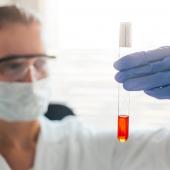More than 160 million chemicals are known to humans. About 40,000 to 60,000 of them can be found in commerce; 6000 of these account for more than 99% of the total volume of chemicals in commerce globally. Chemicals sales are projected to almost double from 2017 to 2030.
Environmental toxins are unavoidable. Many household items that we use everyday contain them, including the food we eat, the water we drink, and the air we breathe. Largely invisible, most go undetected and are harmless if exposure is limited.
However, there has been a dramatic change in the scale and complexity of human exposure to environmental toxins as industrial manufacturing, fossil fuel consumption, and chemical-intensive crop production have grown.
Concurrently, we've seen an increase in conditions like ADHD, autism, childhood cancers, diabetes and obesity. This is the first of three programs about the impact of toxic chemicals on our bodies and how we can treat them.
Our guides today are Dr Carissa Doherty ND and Dr. Sonya Doherty ND. They opened the Natural Care Clinic in Burlington in 2005. Their approach to treatment draws patients from all over the world.
Next time, our focus will be on how to test and diagnose the effects of these toxins in our patients and the clinical protocols we can use to detoxify the body and return it to health.
Key Take-Aways
Defining Environmental Toxins
In general, environmental toxins are substances and organisms that negatively affect health. They include poisonous chemicals and chemical compounds, physical materials that disrupt biological processes, and organisms that cause disease.
The effects of exposure to environmental toxins are countless. Major threats include carcinogens, as well as substances affecting cardiovascular, endocrine, and respiratory functions.
Molds and Mycotoxins
Mycotoxins are naturally occurring toxins produced by certain molds (fungi) and can be found in food. olds grow on a variety of different crops and foodstuffs including cereals, nuts, spices, dried fruits, apples and coffee beans, often under warm and humid conditions. Mold is found in almost half of all homes, and some of these molds produce mycotoxins.
Exposure to mycotoxins can produce symptoms including: constant fatigue, recurring headaches, itchy or painful skin rashes, increasing anxiety, and worsening autoimmune conditions.
Persistent & Non-Persistent Chemicals
Chemicals are released into the environment by human action, for instance, by the use of pesticides. These chemicals persist in the environment for varying lengths of time.
Persistent chemicals are those chemicals that tend to endure in the environment for years after they are released into it. Examples of persistent chemicals are chlorinated hydrocarbons such as aldrin and lindane.
Non-persistent chemicals are those chemicals that linger only for a brief period after their release in the environment. This category of chemicals includes organophosphates which are the most widely used insecticides today.
The chemicals in deodorant or the fragrances in your hair, your hairspray, your shampoo, those are non persistent and your body will eliminate them eventually over time.
Non-persistent chemicals tend to cause poisoning within a few hours of contact.
Once they degenerate, they no longer pose a toxic threat. Persistent chemicals, on the other hand, tend to reveal their hazardous effects over the long term.
Cumulative Effect
There has been a dramatic change in the scale and complexity of human exposure to environmental toxins. We have no idea what all of these toxins together do to the human body. But none of it is good.
Exposure to toxic air, water, soil, and chemical pollution is the largest environmental cause of premature death, according to the Global Alliance on Health and Pollution. GAHP estimates environmental toxins killed 8.3 million people globally in 2017.
For example, autism has been linked to lead and mercury, PCBs, fire retardant, and phthalates. But we've never studied all of those together. The impact of these toxins negatively impacts methylation and mitochondrial function. It triggers cell danger response and oxidative stress and wreaks havoc in the body.
These health effects include birth and developmental defects, blood disorders, damage to the nervous system, damage to the immune system, damage to the reproductive system, and damage to the respiratory system - and cancer.
There is also an epigenetic effect of exposure to toxicity. If your great grandmother was exposed to lead, your children are still dealing with the problems that her exposure caused to your genes.
Clinical Tools for Diagnosing Toxicity
We will do a deep dive into testing and diagnosis in our next program. However, if you're treating patients, they have toxins and the more complicated the case, the more toxins they have.
Also, our tools to assign a toxic health effect are imperfect. Another factor that complicates diagnosis is that there are patients that may have multiple chemical sensitivities, but they have been diagnosed with another condition. The body tries to rid itself of the toxic exposure in multiple ways, and as a result we see multiple impacts and it's challenging to get to the truth of what's happening.
For example, studies done on cord blood showed that the average infant was born with 200 different chemicals in their cord blood. So with the rise in developmental delay and more rare and unique disorders, whether genetic or autoimmune, we should always be looking for toxicity through blood, through urine and through hair tests.
It's important to do toxicity testing at the right time, to know the tests will reveal what they should. If you do the testing too early, you'll get a false sense of security because the tests will come back clean.
Test for microbial toxins first and then move on to chemicals and heavy metals, do that testing at the 3 to 6 month mark.
Failure to Act
Over 85,000 chemicals are produced annually in the United States, but 80% are not tested. Nobody is taking a leadership role to prove safety.
COVID revealed our capacity for mounting an urgent response to an imminent danger to public health. Why isn't environmental toxicity treated with the same sense of urgency?
There is a deep dependence on the materials and energy sources associated with many toxins. For example: plastics, pesticides, fertilizers and fossil fuels. There is also difficulty assessing environmental impact. Finally, financial and political interests play their part.
Medical establishment is not set up to see the big picture on environmental toxicity. A medical doctor works within a system designed to treat symptoms and sickness. They are trained in a specialty which means the treatment occurs in isolation. This approach fails under pressure of environmental toxins which are complex, cumulative and require extensive and often lengthy diagnosis and treatment.
This is why patients with these complex and multifaceted symptoms end up under the treatment of a naturopathic doctor.
Key Quote
“There are some heroes in the research field, Russell L Blaylock is an author and a retired US neurosurgeon. His proposed central mechanism of amino cytotoxicity that can be triggered by things like pesticides, which speaks to what happens in the brain after the exposure is a downstream effect. Dr Naviaux with his landmark paper, The Cell Danger Response talks about damage to the cell membrane from toxicants or microbial toxins.” Dr Sonya Doherty ND
“Six trillion tons of over 85,000 chemicals are produced annually in the United States and 80% are not tested. Chemical manufacturers are not required to prove safety. So this is a real problem because we have these huge companies that are making money from these products. And certainly we're buying these products because we're consumers. But nobody's standing up and taking a leadership role and saying, well, what's the cost?” Dr Sonya Doherty ND
Our bodies are absolutely incredible. Even though these toxins are on a massive scale, we're able to see incredible improvements in our patients. But we have to be appropriately aggressive because the toxins are in very high amounts.”
Dr Sonya Doherty ND
==
The opinions expressed in this Nutramedica program are those of the guests and contributors. They do not necessarily reflect the opinions of Nutritional Fundamentals For Health Inc.
This video is intended for licensed or registered health professionals and students of health professions only. These statements have not been evaluated by the Food and Drug Administration. Information contained in these programs are not intended to diagnose, treat, cure or prevent any disease.



